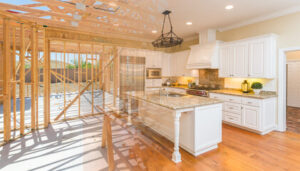Kitchen Remodeling Houston involves making changes to a home’s kitchen to improve functionality or upgrade the style. This can include incorporating smart appliances, quartz countertops, two-tone cabinets, or patterned backsplashes.

The specific features incorporated into a kitchen design depend on the homeowner’s lifestyle. For example, a couple who rarely cooks might only need basic appliances and minimal cabinet storage.
Cabinetry has a major impact on the aesthetics and functionality of kitchens. Understanding the various types of cabinets and their features allows homeowners to make informed decisions that balance style preferences with design and storage requirements.
Kitchen cabinets are available in a variety of styles, colors and materials to complement the overall design theme of the space. While some may have a more traditional or formal look, others offer a sleek and contemporary appeal. The right cabinet design can also enhance a space’s efficiency and organization, making it easier to keep the area clean.
Door styles are another important consideration when choosing cabinetry. Raised panel doors are a popular choice that can work well with a wide range of kitchen designs. Shaker-style cabinets are a simpler option that can be painted or left in a natural wood finish and work well in both modern and traditional kitchens. Flat-panel cabinets have a more minimal look and are simple to maintain because they lack intricate mouldings that can collect dust.
When it comes to kitchen cabinets, the material that they’re made from has a huge impact on how durable and attractive they are. Solid-wood cabinets are considered the most premium, as they offer more durability and a timeless, classic look that can stand the test of time. Other popular options include reclaimed wood, which has been salvaged from old structures and buildings to give rooms a unique and rustic appeal. Wood veneers are another affordable alternative to solid wood, as they offer the look of real wood without the price tag.
While it is possible to refresh existing cabinetry, it’s usually best to hire a professional for a full replacement. Contractors can provide insight and advice, as well as ensure that all work is completed according to industry standards and safety regulations. They can also help homeowners select the right cabinetry to fit their budget and style preferences.
Before beginning a remodel, it’s important to sit down and list all the items you need to store in your new kitchen cabinets. This will help you visualize how much space you need and where everything should go. This step will also allow you to avoid over-buying cabinetry, which can be costly in the long run.
Countertops
Countertops are the primary workspace where you prepare and cook food, so they need to look good at all times and be easy to clean. They also need to work well with the other kitchen elements like cabinets, appliances, and flooring. Old, damaged, or mismatched countertops can ruin the whole look of a kitchen and make it uncomfortable to use. New, durable countertops add value to your home and help you work more efficiently in the kitchen.
During a kitchen remodel, you’ll find a lot of different countertop materials to choose from. Some are heat- and stain-resistant, while others have a unique appearance or texture that stands out. The color and style of your countertops should match the rest of your kitchen so they blend in and complement each other.
If you’re on a budget, you can get a high-quality laminate countertop that imitates the look of natural stone or marble at an affordable price. Laminate countertops are incredibly versatile and come in a variety of colors, styles, and textures. Another great option is a concrete countertop, which is both heat- and stain-resistant and has an organic, industrial look that pairs well with modern kitchen design.
Granite is a popular choice for homeowners because it’s heat- and stain-resistant and comes in a wide array of neutral tones that coordinate with many styles of kitchens. It’s also relatively affordable compared to other premium countertop materials. Another great option is travertine, which has a unique pitted surface and soft, earthy color ranging from beige to rust tones.
You can also choose a recycled material for your countertops, such as glass or plastic. These eco-friendly options have a distinctive look and are very durable. You can even make your countertops more unique by choosing a special edge profile. These can be curved, rounded, or squared to create a more personalized look and improve functionality.
You can also install a waste disposal chute in your countertop to make trash disposal easier and more convenient. This simple upgrade will save floor space and reduce the amount of garbage you need to haul out the door.
Backsplashes
Backsplashes offer a unique opportunity to express your design style. There are a variety of tile patterns, sizes, and materials to choose from that can add visual interest. However, it’s important to consider how you and your family use the kitchen when choosing backsplash materials. For example, if you cook a lot, you’ll want to select durable options that can withstand frequent cleaning and are easy to wipe down.
Backsplash designs can be as decorative as you want, from simple subway tiles with a colorful grout to intricate mosaics. Tiles with a glossy finish are popular because they reflect light and help make small kitchens appear brighter, while matte finishes can prevent the backsplash from appearing overly shiny or creating glare in the kitchen. For a bolder style, try using herringbone or chevron patterns to create a dynamic effect that’s both modern and classic.
Natural materials are a great choice for kitchen backsplashes because they provide an organic element to the room. A stacked stone backsplash offers an earthy look that complements other elements in the kitchen like natural wood cabinetry or hand-hewn beams. Backsplashes made from limestone, slate, or quartz can also coordinate with the color of the countertop and cabinetry to create a seamless aesthetic.
Stacked stone is a highly durable material, but it’s important to consider maintenance requirements when selecting a stone backsplash. Marble and limestone are porous, so they require more regular cleaning than quartz or granite. Alternatively, you can opt for a quartz backsplash, which is an engineered stone product that’s non-porous and requires less regular care.
If you’re on a tight budget, a tile backsplash is still an affordable option. Using an inexpensive tile can also save you money on installation costs. When installing a tile backsplash, it’s important to take accurate measurements and plan out your layout beforehand to ensure a smooth, professional-looking result.
If you’re interested in a more permanent solution, consider using a durable tile with an integrated metal backing that protects the wall behind the stove from heat and moisture. This allows you to create a custom backsplash that adds an artistic focal point to your kitchen while also protecting the wall from damage and making it easy to clean.
Utilities
When rerouting utilities during a kitchen remodel, a licensed plumber must be involved to ensure the safe operation of plumbing and electrical lines. A skilled plumber can help plan a renovation that avoids major utility relocation and save homeowners money on the cost of remodeling.
New lighting fixtures are another easy way to update a kitchen’s look. 2023 is seeing a return to more asymmetrical lighting, with multiple light sources placed throughout the room to draw eyes around the space and add visual interest. Lighting also allows you to highlight key design features, and a change in fixture style can instantly transform the overall tone of your kitchen. Another popular trend is to remove barriers between the kitchen and adjacent rooms, a trend that can make the home feel more open and inviting. Knocking down walls to open up the space is a great way to get an instant boost in usability, and incorporating multifunctional islands and peninsulas can maximize storage and create a sociable atmosphere. Utilities like concealed outlets and fuse boxes can also be transformed into decor by adding aesthetically pleasing frames that hinge open to reveal these important components while still allowing for easy access.
